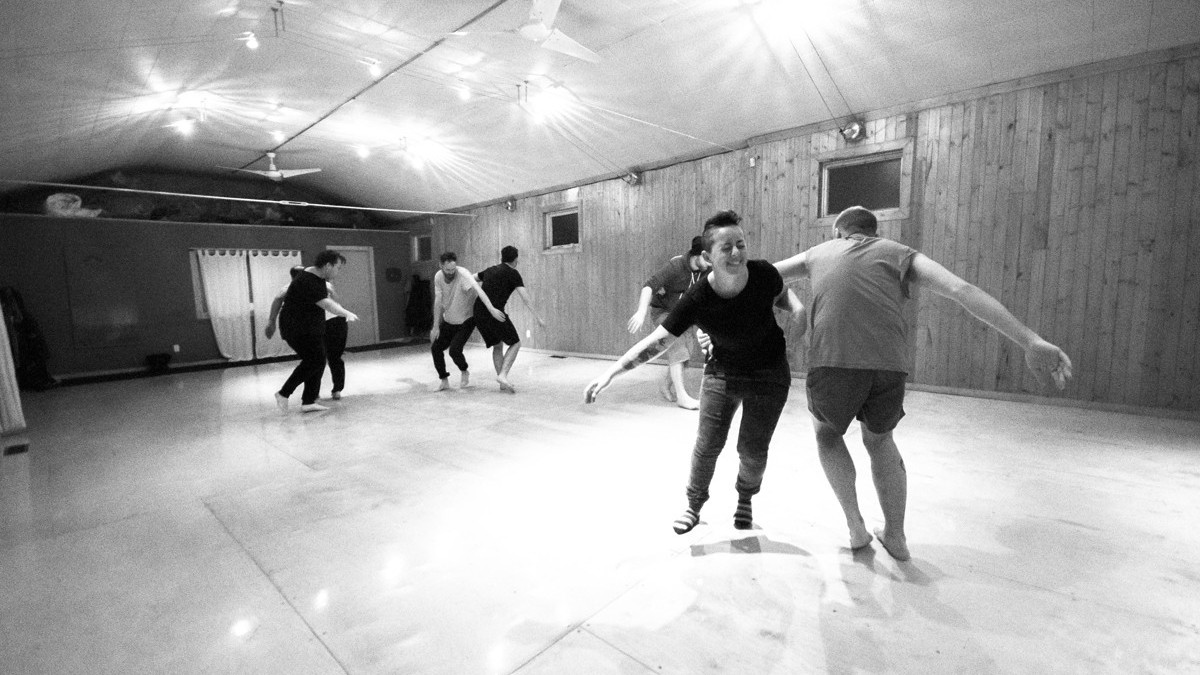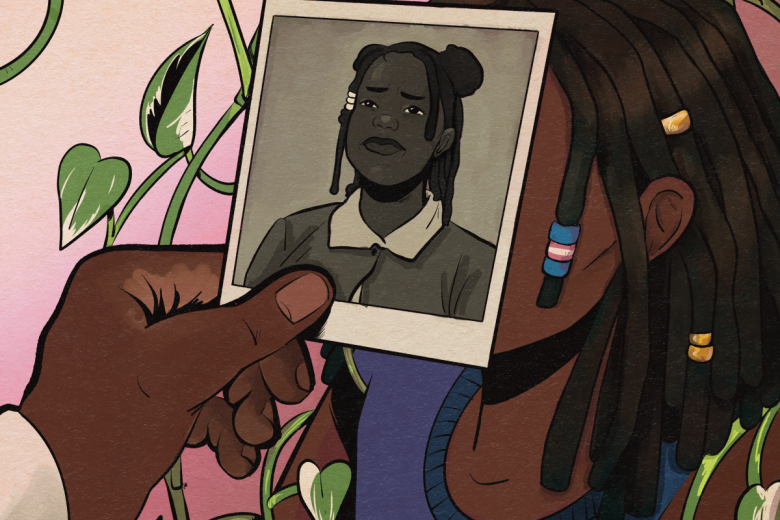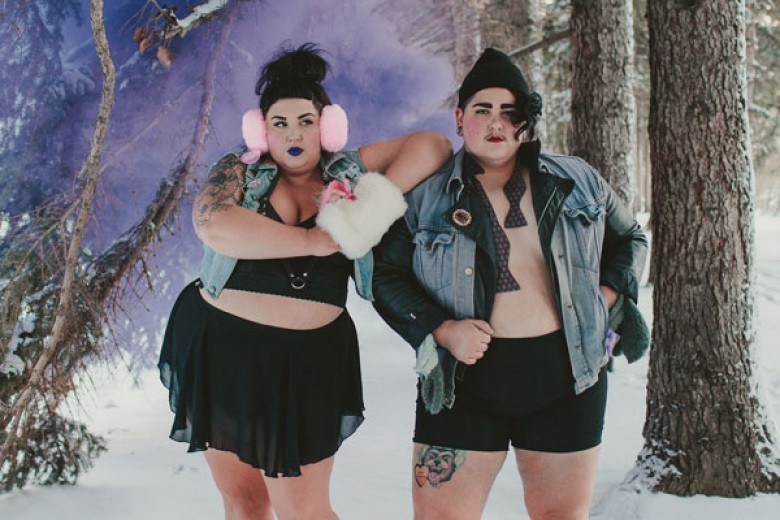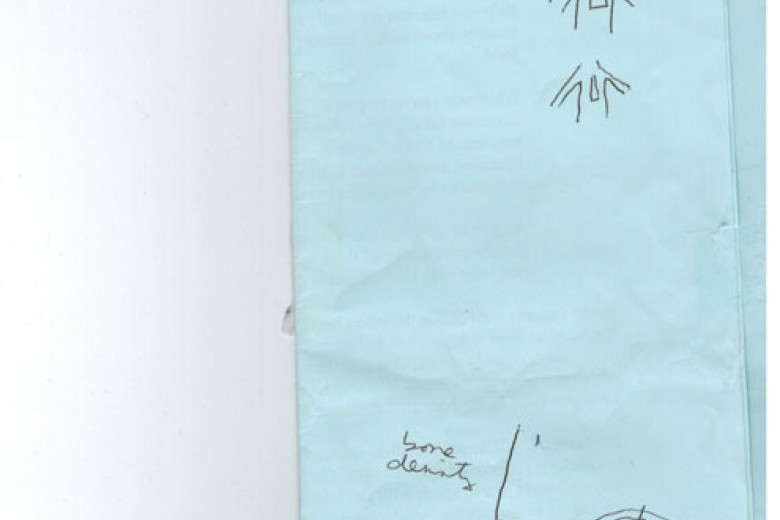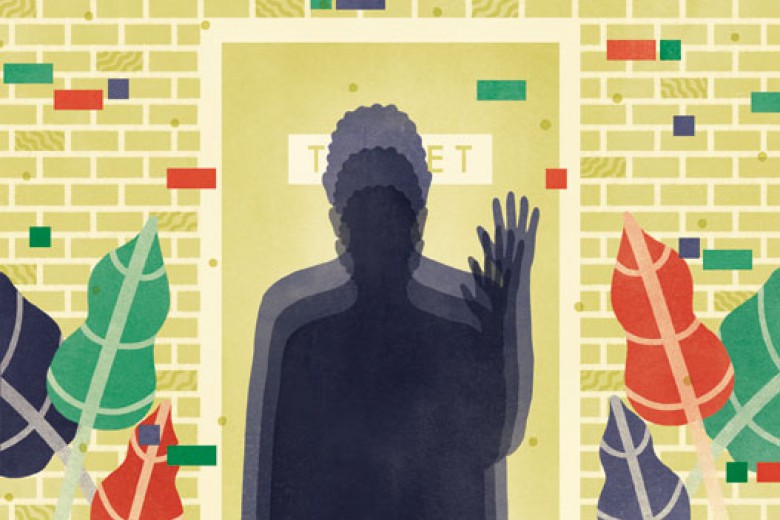That’s me in the photo above, facing the camera, floating in the air. You wouldn’t know it, but I’m messing up a dance move. I was supposed to put my left arm around my dance partner’s back, but instead, I put it around his front torso. The expression on my face is one of embarrassment, but also joy.
I’ve always loved to dance. I took nine years of ballet and jazz classes when I was younger, but I didn’t think I’d dance as an adult. I’d wanted to join FadaDance – a contemporary dance school in Regina – but I didn’t see myself reflected in their year-end performances. I’m genderqueer, I use they/them pronouns, and I present as trans masculine. Finding a dance class that wasn’t gender-normative or heteronormative seemed unlikely.
Most of FadaDance’s adult classes are filled with cisgender femme women. At performances, many of the dancers wear makeup and dresses or tight-fitting outfits, and perform dance moves that I don’t want to do. Cis men have occasionally joined these classes, but I wasn’t sure how I, as a genderqueer person, would be treated. Would the instructors make an effort to use my pronouns? If another dancer misgendered me, how would it be handled? Would my body hair offend people? I worried, too, that I’d be expected to move or dress in certain ways based on my biology and not on my gender identity.
There was one FadaDance class I was interested in, and that was FadaMan. But as the name suggests, this class was open to “people who identify as men.” I don’t identify as female or male.
Finding a dance class that wasn’t gender-normative or heteronormative seemed unlikely.
This wasn’t the first time I’d wanted to access a space exclusively for men. In the summer of 2014, I tried to get my hair cut at a barbershop and was denied service. At the time, I identified as a woman and was told the barbershop wouldn’t give me a men’s haircut because I’m not a man. I did a media interview, calling it blatant discrimination, and was harassed online and publicly humiliated. With this awful experience in mind, I was reluctant to try joining FadaMan. Fortunately, my experience with FadaDance has been markedly different from the one I had with the barbershop.
Last fall, I stood at my closet trying to calm my nerves and decide what to wear to the first of three Queering Dance workshops offered in Regina. I was anxiety-ridden, excited, apprehensive, curious. I stepped into a pair of jogging pants and threw on a muscle shirt that exposed my armpit hair.
The workshops – offered by FadaDance in partnership with Common Weal Community Arts – were inspired by conversations between two of my dear friends, Claire Carter, an assistant professor in women’s and gender studies, and Risa Payant, executive director of Common Weal. In the summer of 2017, Claire and Risa began imagining the possibility of a trans-, queer-, and body-positive dance space in Regina. They invited Frank Gilboy and Heather Cameron of FadaDance to lead the workshops and received a Faculty of Arts Creative Research Award to fund a pilot project. Before the workshops were held, Risa, Frank, and Heather participated in a UR Pride Positive Space workshop to learn how to foster inclusive and respectful spaces for people of diverse genders and sexualities.
I participated in two of the three Queering Dance workshops. The first was open exclusively to transgender and non-binary folks. The second was open to trans, non-binary and queer folks. The third was open to all of the above as well as body-positive allies.
Although the workshops followed a similar structure to a regular FadaDance class, with a mix of stretching, improvisation, and choreography, they differed in small but important ways. They opened with a pronoun circle. They included improv exercises that encouraged us to take up space and make eye contact with one another – things that aren’t always permitted to people who violate gender norms. Frank and Heather referred to us as “dancers” or “folks” instead of “guys” or “ladies.”
Toward the end of the first workshop, I realized that I had forgotten about my gender while dancing. I don’t typically have the privilege of not thinking about gender. I think about it in the morning when I decide whether I can tolerate the pain of binding my chest that day. I think about it when people misgender me, and on the rare occasions when they gender me correctly. I think about it every time I have to enter a public washroom that’s marked “women” because the only other option is a space marked “men.” These thoughts aren’t neutral – I don’t just notice that the washroom is marked “women” and move on. They’re heavy, distressing moments. They accumulate throughout the day, month, year into a deep sense of frustration.
Toward the end of the first workshop, I realized that I had forgotten about my gender while dancing.
I loved dancing in a class that was created specifically for trans and non-binary folks. I didn’t have to explain to the other participants what genderqueer meant, or answer questions about my pronouns, or feel self conscious about my gender presentation. They got it.
So the queering dance workshops felt freeing – for me, anyway. While my experience was positive, I also noticed that most of the participants were cisgender and white. It’s possible that transgender folks and people of colour didn’t trust the space, or the project, which was initiated by white cis folks.
The workshops weren’t perfect. At the end of each, we were given an opportunity to provide feedback. Sometimes the instructors made mistakes. Sometimes we pointed them out. They usually thanked us.
Dancing in the workshops, I was reminded of how much I missed choreographed dance. I wished that I could join a Fada class. But which one? During a feedback session after a workshop, I told Frank and Heather that I was interested in FadaMan but that I was also nervous about joining a men’s class. They encouraged me to join, and committed to doing the work necessary to ensure I felt welcomed.
Both Frank and Heather, along with FadaDance founder Misty Wensel, had long discussions about redefining the boys’ and men’s programming to include transgender and non-binary folks. They consulted with UR Pride about how to proceed. They re-named FadaMan to FadaMasc, short for masculine, at Claire’s suggestion. They re-defined the class, opening it up to all “who identify with a more masculine way of moving in the world,” and they checked in with me periodically throughout the process, always centering my comfort.
Sometimes the instructors made mistakes. Sometimes we pointed them out. They usually thanked us.
At the first class, Heather and Frank led a pronoun circle that wasn’t taken seriously by some of the cis-male dancers – likely because they’d never been asked to announce their pronouns before. At the next class, Frank took the initiative to explain why it’s an important practice.
Frank and Heather could have reacted defensively throughout the process. They could have tried to maintain FadaMan as they had originally envisioned it. It was, after all, their baby. Created in 2008, FadaMan was conceived of in response to cis men wanting a male-only space in which to explore dance – a typically female-dominated activity. The class was popular, with an enrolment of 16 men by its second year. Audiences loved FadaMan. Local organizations requested FadaMan performances at their events. FadaMan was a success. And yet, when the class was critiqued for excluding trans masculine folks, FadaDance School listened and changed it.
So now, on Tuesday nights, I dance. Turns out I’m actually not very good at dancing, but that’s okay. I feel accepted by the dancers in the class and supported by Heather and Frank. I get to be part of a class that affirms my masculine gender identity. I get to wear matching outfits with my cis-male classmates, and perform a choreographed routine that we will have practiced as a team in front of an audience on December 22 at the Exchange in Regina.
A couple of weeks ago, one of the other dancers sent me a message that said, “So great to have you with us. I always thought you might join one day.” And my genderqueer heart did a somersault.
Thanks to photographer and FadaMasc dancer Shawn Fulton for capturing the joy on my face while making a mistake. I think both Frank and Heather would be okay with me saying they’ve made mistakes throughout FadaMan’s transition to FadaMasc – that’s natural. It’s their commitment to owning their mistakes, to ensuring I feel supported, and their genuine desire and continued effort to get it right that has made this experience joyful.


